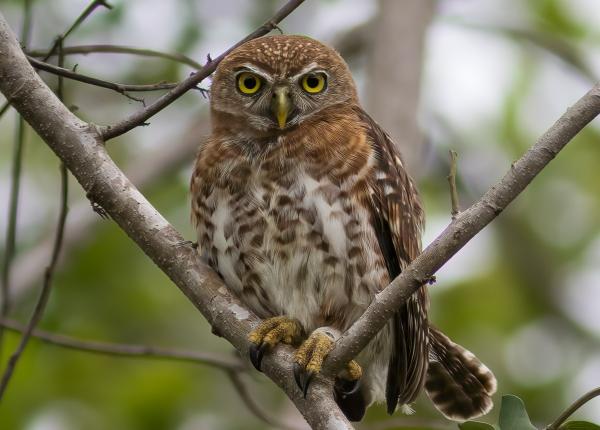Did You Know?
- There are three subspecies of Cuban Pygmy-owl
- This small owl is frequently seen in the day time
- The Cuban Pygmy-owl is Cuba's most common owl species.
How The Peregrine Fund is Helping
Though The Peregrine Fund does not work directly with Cuban Pygmy-owls, our efforts in scientific research, habitat conservation, education, and community development help conserve birds of prey around the world. We also supply literature to researchers from our avian research library, which helps scientists around the world gather and share important information on raptor conservation. Our work with the Neotropical Raptor Network helps conserve raptors by fostering collaboration and communication among raptor enthusiasts in the region. And, finally, our support of the Global Raptor Information Network gives raptor researchers tools to more efficiently conduct their own studies while contributing to a global program. It also provides citizen scientists a way to participate in raptor science and conservation.
Where They Live
The Cuban Pygmy-owl, like the Bare-legged Owl, is endemic to Cuba. It is found in a number of different habitats including dry and moist forests and human-altered habitats.
What They Do
Cuban Pygmy-owls are brownish with light spotting. They have dark "eye spots" on the back of their necks. These "eye spots" aren't real eyes, of course, but they sure look like them. In fact, they look enough like real eyes to fool potential predators into thinking that the owl is looking right at them, rather than in the opposite direction.
These small owls are both diurnal and nocturnal, and are quite easy to spot during daylight hours. They have a distinctive call that has been described as a series of evenly-spaced notes. While their more rapid alarm call is best described as "squeaky and high-pitched"!
Why They Need Our Help
The Cuban Pygmy-owl is classified as Least Concern. This means its population isn't in trouble at least in the foreseeable future. However, habitat destruction is a problem for the species and could prove to have a negative effect on the species in the long term.
What They Eat
As you probably might guess, a small owl tends to hunt small prey. In the case of this species, it most often hunts insects, small lizards, as well as small birds and mammals.
Nests, Eggs and Young
The Cuban Pygmy-owl is a cavity nester, most often nesting in tree cavities excavated by woodpeckers. The female will lay 3-4 eggs. The female does all of the incubation of the eggs. Apart from this basic information, not much else is known about the nesting habits of this lovely owl.
Cuban Pygmy-owl and the World Center for Birds of Prey
The World Center for Birds of Prey offers fun ways to learn about raptors. Interactive activities, tours, interesting videos and a children's room with activities from coloring sheets to quizzes to costumes await you. At our visitor center, you can see live owls up close - such as a Verreaux's Eagle-owl or a Western Screech-owl, and learn about the wonderful and interesting adaptations they have in order to survive in their respective habitats. There is also a touch table with owl feathers and other natural objects available for exploration. Take a stroll along a short nature trail and look for Barn Owls or even a Northern Saw-whet Owl perched in the trees.
References:
BirdLife International. 2016. Glaucidium siju. The IUCN Red List of Threatened Species 2016: e.T22689262A93224271. https://dx.doi.org/10.2305/IUCN.UK.2016-3.RLTS.T22689262A93224271.en. Downloaded on 29 November 2021.
Holt, D. W., R. Berkley, C. Deppe, P. L. Enríquez, J. L. Petersen, J.L. Rangel Salazar, K.P. Segars, K.L. Wood, G. M. Kirwan, and J. S. Marks (2020). Cuban Pygmy-Owl (Glaucidium siju), version 1.0. In Birds of the World (J. del Hoyo, A. Elliott, J. Sargatal, D. A. Christie, and E. de Juana, Editors). Cornell Lab of Ornithology, Ithaca, NY, USA. https://doi.org/10.2173/bow.cupowl1.01









